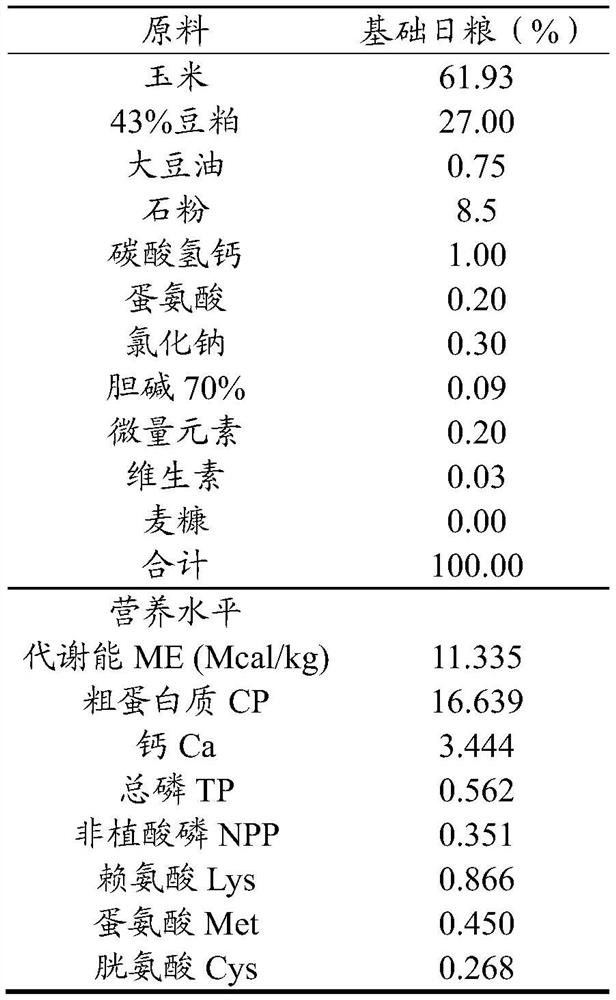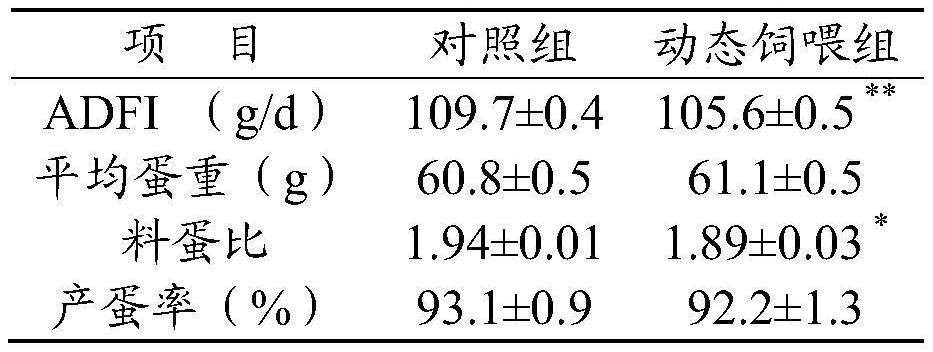Method for Improving Laying Performance of Laying Hens
A technology for laying eggs and hens, which is applied in animal husbandry and other fields, can solve problems such as food intake and feed intake increase the burden on the gastrointestinal tract of animals, reduce the ability to digest and absorb nutrients, and affect the health of the gastrointestinal tract of animals. Achieve the effects of improving egg production performance and egg quality, increasing feed cost, and increasing eggshell thickness
- Summary
- Abstract
- Description
- Claims
- Application Information
AI Technical Summary
Problems solved by technology
Method used
Image
Examples
Embodiment 1
[0027] Embodiment one: dynamic feeding test
[0028] 1 According to the feed formula table for Hai-Line brown layer hens in the late laying period, the basic ration was formulated (as shown in Table 1), and the ration with a calcium content of 3.444% was obtained, and stored in a dry place away from light after bagging.
[0029] Table 1 Feed formula for Hailan brown layer hens in the late laying period
[0030]
[0031] 2 Experimental design
[0032] 2.1 Test materials and grouping
[0033] In this experiment, 70-week-old Hailan brown layer hens were selected as experimental animals. The average daily feed consumption was 120g / hen, and they were fed at 8:00 am and 2:00 pm every day. Calculate according to the number of chickens actually stored in the cage. Select 144 chickens in good health and condition, and randomly divide them into 2 groups, with 6 repetitions in each group and 12 chickens in each repetition. Feed consumption throughout the day; the dynamic feeding g...
Embodiment 2
[0077] Embodiment two: dietary calcium reduction test
[0078] 1 Formulate a calcium-reducing diet
[0079] 1.1 According to the standard of reducing the total calcium content from 3.44% to 3.01% (that is, a drop of 12.5%), reduce the stone powder in the feed of Hailan brown layer hens in the late laying period from 8.50% to 7.30%;
[0080] 1.2 Use 1.20% chaff to make up the proportion of stone powder removed.
[0081] Fully mix 1.1 and 1.2 with the raw materials of the diet (as shown in Table 9) to obtain a diet with a calcium content of 3.0%, and store it in a dry place away from light after bagging.
[0082] Table 9 Feed formula table for Hailan brown layer hens in late laying period
[0083]
[0084] 2 Experimental design
[0085] 2.1 Test materials and grouping
[0086] In this experiment, 70-week-old Hailan brown layer hens were selected as experimental animals. The average daily feed consumption was 120g / hen, and they were fed at 8:00 am and 2:00 pm every day. C...
Embodiment 3
[0127] Example 3: Two-factor test of dietary calcium reduction and dynamic feeding
[0128] 1 Formulate a calcium-reducing diet
[0129] 1.1 According to the standard of reducing the total calcium content from 3.44% to 3.01% (that is, a drop of 12.5%), reduce the stone powder in the feed of Hailan brown layer hens in the late laying period from 8.50% to 7.30%;
[0130] 1.2 Use 1.20% chaff to make up the proportion of stone powder removed.
[0131] Fully mix 1.1 and 1.2 with the raw materials of the diet (as shown in Table 9) to obtain a diet with a calcium content of 3.0%, and store it in a dry place away from light after bagging.
[0132] 2 Experimental design
[0133] 2.1 Test materials and grouping
[0134] In this experiment, 70-week-old Hailan brown layer hens were selected as experimental animals. The average daily feed consumption was 120g / hen, and they were fed at 8:00 am and 2:00 pm every day. Calculate according to the number of chickens actually stored in the ca...
PUM
 Login to View More
Login to View More Abstract
Description
Claims
Application Information
 Login to View More
Login to View More - Generate Ideas
- Intellectual Property
- Life Sciences
- Materials
- Tech Scout
- Unparalleled Data Quality
- Higher Quality Content
- 60% Fewer Hallucinations
Browse by: Latest US Patents, China's latest patents, Technical Efficacy Thesaurus, Application Domain, Technology Topic, Popular Technical Reports.
© 2025 PatSnap. All rights reserved.Legal|Privacy policy|Modern Slavery Act Transparency Statement|Sitemap|About US| Contact US: help@patsnap.com



